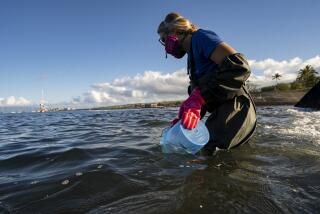Scientists off Southern California explore why some fish glow
Glowing fish are turning out to be far more common than scientists had assumed, and now researchers swimming in Southern California waters may have figured out why.
After using a custom-built “shark eye” camera to confirm that swell sharks can see one another glow, the research team reported that the animals probably use that light to communicate among themselves.
The discovery was published this week in the journal Scientific Reports.
“The green glow isn’t just pretty,” said study coauthor Dimitri Deheyn, a marine biologist at the Scripps Institution of Oceanography in La Jolla. “The fluorescence helps swell sharks to survive in the ‘twilight zone’ — the area of the ocean where light from the surface begins to fade away.”
The sharks transform faint blue light in the ocean into a fluorescent green color, a process called biofluorescence. Humans can’t see the eerie glow unless they wear certain eye filters.
The report marks the first time scientists have proved that a species of fish can see the glow it produces, and that fluorescence probably plays an important role in communication — possibly for essential needs such as mating.
Scientists have long known that the ocean is home to various things that glow. But until recently, they didn’t realize that many fish are biofluorescent.
That discovery was partly tied to a “photo-bombing” by an eel.
Workers at the American Museum of Natural History were in the process of creating a photo exhibit about fluorescent coral when they noticed a glowing eel in some of the images.
This led scientists to look for other fish that are biofluorescent. They have found scores of them around the world during the last two years. In addition to swell sharks, biofluorescent species include chain catsharks, flatfish, scorpionfish, breams and some seahorses.
“The question became, ‘Why do they glow?’” said study leader David Gruber, a biologist at Baruch College in New York and research associate at the museum. “It’s mystifying. We don’t understand it, so we decided to research it further.”
His curiosity brought him to La Jolla, which has something he needed for the project: access to biofluorescent swell sharks, an animal whose vision is fairly well understood.
The small, harmless creatures are known to swim along the edge of Scripps Canyon, a marine wonderland that’s within swimming distance of Black’s Beach.
Gruber and his colleagues entered the water from a dive boat, carrying the specialized camera that simulates how swell sharks process light. They mostly dived at night, and they sometimes had to deal with dicey currents as they moved 80 to 130 feet below the surface along a wall of the canyon.
“The camera weighed more than 100 pounds and didn’t exactly glide through the water,” said Gruber, an experienced diver. “But the hard part involved finding the sharks.
“We had scouts who’d look in the grooves of the canyon wall, where the sharks sometimes hang out. But we didn’t always find them,” he said. “It was thrilling when the sharks appeared and we had the camera in focus.”
Deheyn, also an experienced diver, has observed biofluorescence around the world, in places such as Fiji and Panama.
“It’s a magical experience,” he said. “Every time you see it, you learn something new.”
gary.robbins@sduniontribune.com
Twitter: @grobbins
Robbins writes for the San Diego Union-Tribune.






